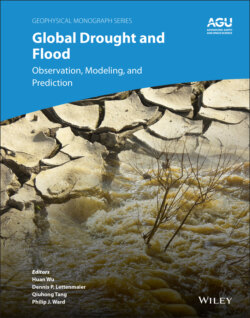Читать книгу Global Drought and Flood - Группа авторов - Страница 37
2.4.2. GOES ET and Drought Product System Design
ОглавлениеThe GET‐D system provides a framework of interpreting LST and vegetation index for remote sensing drought signals within the context of a physically based energy balance model, i.e., ALEXI. Using brightness temperature measurements at morning times, and initial estimates of near‐surface temperature, the surface component of the ALEXI model yields instantaneous sensible heat flux estimates (Anderson et al., 1997). A simple SLAB model is used in ALEXI to describe the dynamics of its ABL component. The sensible heat flux estimates from both the surface and ABL components of the ALEXI model are iterated until the time‐integrated sensible heat flux estimates from both components converge. Then the instantaneous satellite‐based flux estimate is extrapolated to daily fluxes by assuming the evaporative fraction is constant during daylight hours for a given day. A simple ESI, which represents anomalies in the remotely sensed ET/PET fraction generated with the ALEXI model flux estimates, is then computed as a drought monitoring tool.
Figure 2.2 The GOES evapotranspiration and drought product (GET‐D) system design: SM, soil moisture.
Table 2.2 GET‐D system outputs
| Variables | Source | Spatial domain | Spatial resolution (km) | Description |
|---|---|---|---|---|
| ET product with QC | GET‐D | North America | 8 | Daily ET map |
| ESI products with QC | GET‐D | North America | 8 | 2,4,8, 12‐week composite drought map |
| Flux products with QC | GET‐D | North America | 8 | Daily sensible heat and soil heat flux map |
| Radiance products with QC | GET‐D | North America | 8 | Daily short wave down, long wave down, long wave up and net radiation map |
Figure 2.2 shows the design of the GET‐D system. The GET‐D system consists of the following six major modules
1 Meteorological forcing process (MFP) module preprocesses meteorological forcing data and resamples the required forcing variables to the ALEXI model domain.
2 Satellite data sets process (SDP) module preprocesses satellite data including GOES LST, GSIP insolation, vegetation index, cloud mask, and snow mask and resamples the data sets to the ALEXI model domain.
3 Ancillary datasets process (ADP) module preprocesses ancillary data sets including land cover, albedo, and satellite viewing angle.
4 ALEXI module is the core of the GET‐D system that executes the ALEXI model and estimates flux and ET.
5 Quality control flag (QCF) module generates pixel‐based quality control flags for product quality monitoring purposes.
6 Product output (POP) module produces the GET‐D final product in NetCDF, GRIB2 and PNG formats.
Major data inputs and outputs of the GET‐D system are provided in Table 2.1 and Figure 2.2, respectively.
